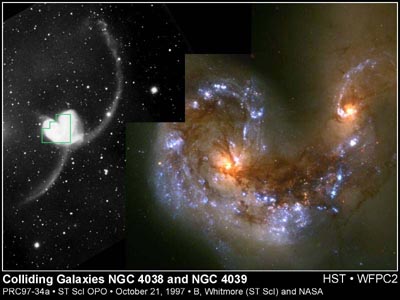Well, this is a golden oldie, but it is a lovely picture all the same and it looks great here.
In
another thread, Chris said:
We may well merge with Andromeda, which is about the same size as the Milky Way, or slightly larger, in a few billion years. That's the soonest this could happen, and by that time the Earth will not be supporting human life. So we won't have the opportunity to enjoy the interesting new night sky.
Interesting new night sky, indeed! The night sky if you live in either NGC 4038 (the topmost galaxy in today's APOD) or in NGC 4039 (the bottom one) the night sky would look fabulous indeed. Unless, of course, you were actually sitting inside the thick dusty "bridge" joining the two galaxies, where you would be lucky to see much at all. On the other hand, there is so much star formation going on inside this huge dusty patch that if you were inside, you would be lucky not to be fried by all the intense ultraviolet light and all the energetic jets zapping the neighbourhood in there.
If you did have a clear view, however, how amazing it would be! Look at all the super-clusters in NGC 4039! Wowzers! And how interesting it is to compare NGC 4039 and 4039. Clearly most of the star formation goes on inside NGC 4038, which must have been a gas-rich spiral before it had its close encounter with 4039. The latter galaxy, by contrast, was probably a gas-poor disk galaxy before it ran into 4038. It may even have been a S0-type disk galaxy with no star formation at all. Compare the color and texture of the disks of 4038 and 4039 beyond the raging star formation and dramatic dust. The disk of 4038 is mottled and sprinkled with young blue star clusters, but the disk of 4039 is almost perfectly smooth and beige in color, because it is made up of uniformly distributed old yellow stars.
And to think that this fantastic cosmic fireworks will eventually produce... a featureless yellow ball of stars, an elliptical galaxy. How boring. Will there be anything to look at in the sky of a planet inside an elliptical galaxy, anything but a uniform sprinkling of stars in the sky? Will there be any recognizable patterns of constellations? I doubt it. There will be no Big Dippers inside elliptical galaxies, or that is what I think anyway. But there will be stars like Arcturus, bright-looking red giants, which may liven up the sky a bit. Also, of course, you would be able to see the your own galaxy in the sky, which for a planet inside an elliptical galaxy would look like a gradual circular or elliptical brightening in one direction of the sky, culminating in a brilliant core. In a dust-free environment you should be able to see the core of your own galaxy very well.
Ann
 The Antennae Galaxies in Collision
The Antennae Galaxies in Collision
